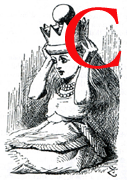
aricature-style illustrations of the 1830s and 1840s evolve from sixteenth-century mock portraits by Annibale Carracci, satiric eighteenth-century progresses by William Hogarth, and individual comic prints by Hogarth’s heirs, James Gillray, Thomas Rowlandson, and George Cruikshank, who earned a reputation for his early nineteenth-century satiric plates before he entered the field of book illustration. The term “caricature” derives from the Italian “caricare,” which means “to overload” or “surcharge.” Beginning with Gillray and Rowlandson, Cruikshank’s direct forebears, comic “prints and similar products began to be called ‘caricatures,’” note E. H. Gombrich and E. Kris in Caricature (19). “Aims and means were the same in both types — to ridicule and castigate by means of light-hearted playful distortion” (19). Distortion and exageration have come to stereotype the achievement of caricaturists and diminish their contribution to the Victorian illustrated book, but even those invested in Sixties illustration recognize that the caricature school of illustration is “above all, theatrical” (Goldman and Cooke 28).
In its theatricality, caricature-style illustration approximates the dramatic tableau, a style of performance that predates the nineteenth century but is closely associated with nineteenth-century drama. Defined inclusively, “tableaux vivant or ‘living picture,’ refers to the representation of some well-known person, scene, or incident, whether taken from a verbal or visual source, by a performer or performers who, appropriately attired and positions, hold their poses silently and motionlessly” (J. Hill 328). In the nineteenth century, charades, private theatricals, and tableaux vivants were enormously popular forms of entertainment in private homes among members of the upper middle class and gentry. . . . In England, James Robinson Planché and Douglas Jerrold established the tableaux vivant on the London stage with respectively, The Brigand (1829), based on three paintings by Sir Charles Eastlake, and Rent Day (1832), after two Paintings by David Wilkie. Painting, drama, and fiction were interdependent genres, as Martin Meisel reminds us: “In the nineteenth century all three forms are narrative and pictorial” (3).
Bibliography
Golden, Catherine J. Serials to Graphic Novels: The Evolution of the Victorian Illustrated Book.” Gainesville: University of Florida Press, 2017.
Gombrich, E. H., and E. Kris. Caricature. London: Penguin Books, 1940.
Hill, Jonathan E. “Cruikshank, Ainsworth, and Tableaux Illustration.” Victorian Studies. 23.4 (Summer 1980): 429-59.
Meisel, Martin. Realizations: Narrative, Pictorial, and Theatrical Arts in Nineteenth-Century England. Princeton: Princeton University Press, 1989.
Last modified 7 April 2019